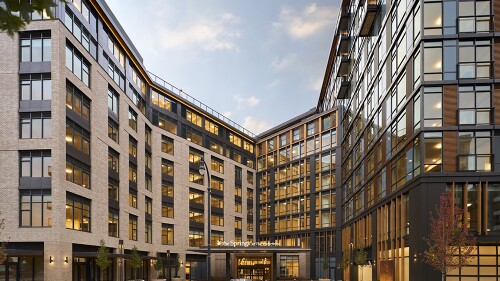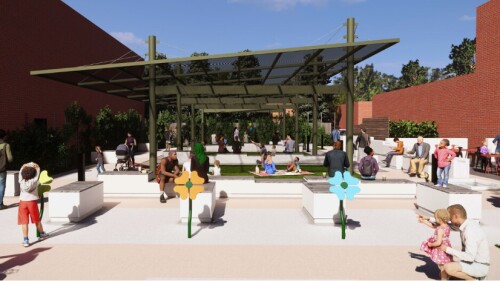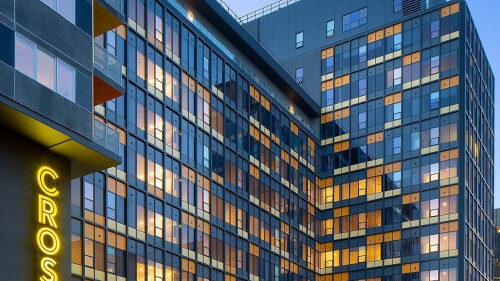Topics
Capital Markets and Finance
The search for new growth and potential out-performance is shifting real estate allocations toward niche sectors such as cold storage, medical office, single-family rentals (SFR), and senior housing.
With a rapidly expanding market, navigating the sea of financing mechanisms is a challenge. These are more than just funding sources. They are strategic tools that channel capital into sustainable projects while also managing environmental risks and delivering financial returns.
Los Angeles-based impact fund manager SDS Capital Group has launched a new capital platform—SDS Impact Debt (SDSID)—that aims to bring much needed, low-cost debt to the affordable housing market. It is an asset-backed model that offers below-market financing (both permanent and construction) for affordable housing projects—and is potentially scalable across the U.S.
Design & Planning
Located on the site of the former Ritz Theater, the South Grand Community Improvement District in St. Louis spearheaded the transformation of Ritz Park in 2014 from vacant lot to popular gathering spot for movies, concerts, plays, markets, and festivals. Unfortunately, the new space was devoid of shade, making it too uncomfortable for daytime use during the summer.
The creation of public space from unused, underused, or unequally shared linear spaces in urban areas has been happening for a long time. Major reference points in the architectural and planning worlds are Boston’s Emerald Necklace, designed by Frederick Law Olmsted (1878–1896); Freeway Park in Seattle (1972-1976); the Baltimore Inner Harbor (1963–1983); the Promenade Plantée in Paris (1987-1994); and the High Line in New York (2005–2019).
A redevelopment plan for a former industrial site in Cleveland presented by a team of Harvard University and Massachusetts Institute of Technology students has taken top honors in the 23rd annual ULI/Gerald D. Hines Student Urban Design Competition. This year’s competition asked students for proposals to create a vibrant, mixed-use, mixed-income area on a former industrial site in on Cleveland’s East Side.
Development and Construction
As drones and electric flying vehicles mature, China imagines a new urban landscape
A shuttered higher-education campus receives new life as housing for older adults while providing significant benefits to the surrounding community
Finding success in deploying a collaborative strategy to combat the local housing crisis.
Resilience and Sustainability
The ULI Randall Lewis Center for Sustainability in Real Estate and the Insurance Institute for Business and Home Safety (IBHS) brought together executives in the commercial real estate and property insurance industry on May 13, 2025, in conjunction with the ULI Spring Meeting and Resilience Summit in Denver, Colorado, to discuss strategies for operating in this environment of growing risk. As Mary Ludgin, event facilitator and senior advisor at Heitman, noted, “Increased conversation between property owners and insurers is a crucial step in managing risk and controlling costs in a tumultuous time of heightened physical risk.”
The ULI Net Zero Imperative (NZI) is ULI’s multiyear initiative to accelerate decarbonization in the built environment and advance the organization’s net zero mission priority. Implemented by the ULI Lewis Center for Sustainability in Real Estate, key programs include Technical Assistance Panels (TAPs), which are intense three-day engagements during which a panel of ULI member experts and partners help clients or sponsors, often local governments, think through strategies for advancing their net zero goals.
The new ULI report explores how developers can find both profit and purpose by embracing the potential of existing buildings, illustrated through three case studies that generated tangible value for communities and investors alike.
Issues and Trends
The Lewis Center for Sustainability Forum commemorated the 10th anniversary of its Building Healthy Places Toolkit, a pivotal resource designed to integrate health and wellness into real estate development. The forum—held on the first day of ULI’s 2025 Spring Meeting, in Denver, Colorado—brought together industry leaders, each of whom highlighted the toolkit’s significant impact and the evolving focus on health within the built environment.
Developer sought to improve people’s lives through her work.
Local governments are rolling out new and updated programs—including tax incentives and zoning amendments—to encourage developers to convert vacant office buildings to some other use.















